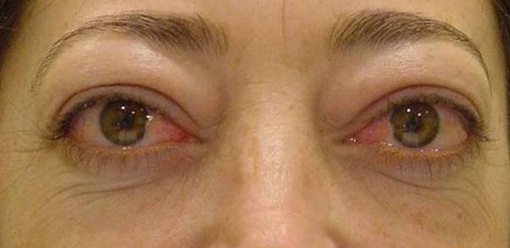Thyroid orbitopathy (also known as Graves’ Disease) is an autoimmune inflammatory disorder of uncertain etiology that affects the tissues of the orbit (i.e. eyelids, extraocular muscles and other soft tissues surrounding the eyes).
 Patients with this disorder often have an associated thyroid abnormality which may manifest either before, during or after the orbital signs and symptoms. However, a small percentage of patients may have eyelid and orbital manifestations of the disorder without developing a thyroid abnormality.
Patients with this disorder often have an associated thyroid abnormality which may manifest either before, during or after the orbital signs and symptoms. However, a small percentage of patients may have eyelid and orbital manifestations of the disorder without developing a thyroid abnormality.
Thyroid orbitopathy can develop and affect patients with varying degrees of severity. The disease can begin suddenly and progress rapidly over days to weeks or start insidiously and progress gradually over a long period of time. The majority of patients have mild inflammation, the most common signs and symptoms of which are retraction of the upper and/or lower eyelids and bulging of the eyes (also known as proptosis). In cases of moderate inflammation, patients may also have varying degrees of double vision and eyelid swelling as well as visible redness of the lids and eyes.
A small percentage of patients with thyroid eye disease develop severe inflammation, which can result in compression of the optic nerve and permanent vision loss. In most cases, the inflammatory process is self-limited and runs a course lasting 6 months to a few years before subsiding. After the inflammatory phase of the disease subsides, scarring of eyelid and orbital tissues may result in the persistence of eyelid retraction, proptosis and double vision.
Evaluation and Management of Thyroid orbitopathy
It is important to be evaluated by an ophthalmologist to assess the ophthalmic manifestations of the disease as well as by an endocrinologist to manage concurrent thyroid abnormalities. Patients with mild orbitopathy are usually evaluated on an interval basis to monitor progression of the disease and managed with measures to reduce ocular symptoms.
Patients with moderate to severe orbitopathy may require medical or surgical intervention to reduce inflammation or improve vision. Once the inflammatory phase of the disease has subsided, patients with eyelid abnormalities, double-vision or proptosis may be eligible for surgical correction to improve their function and appearance.
Cigarette smoking has been associated with development of worsening thyroid orbitopathy, therefore cessation of smoking is universally recommended in these patients.
Error: Formulario de contacto no encontrado.
